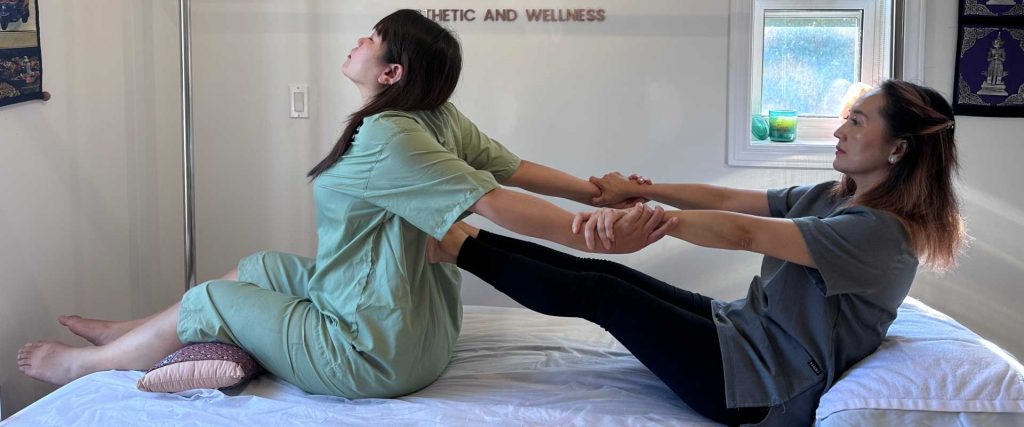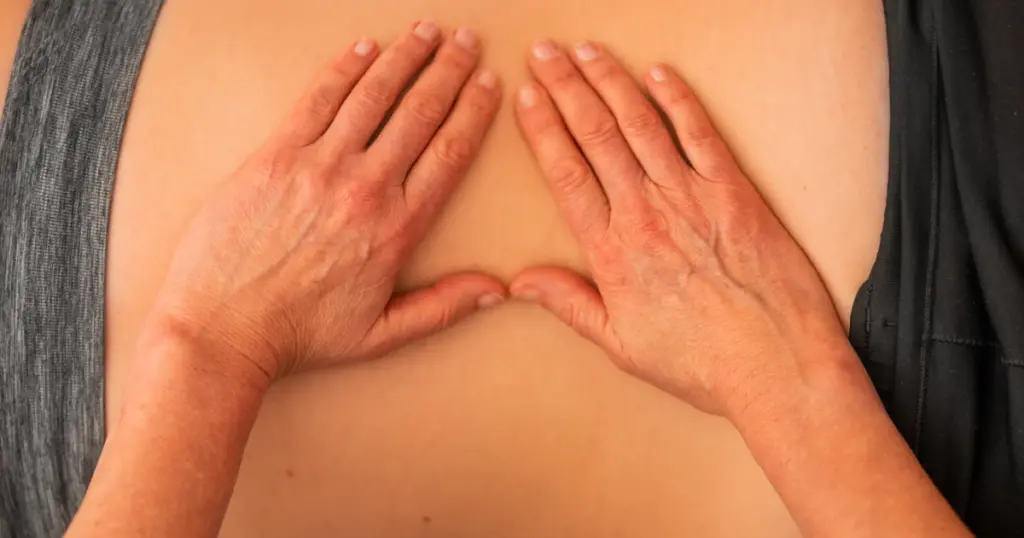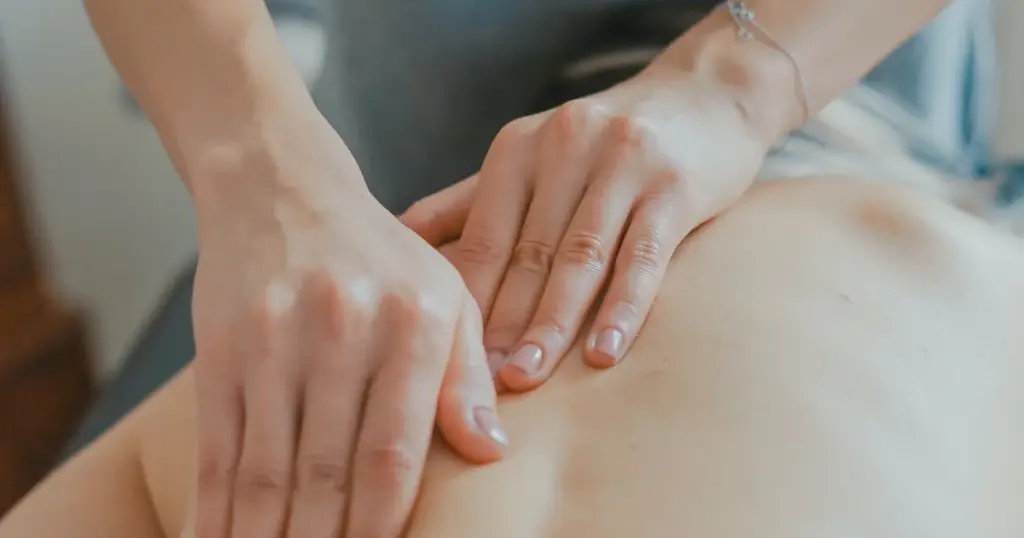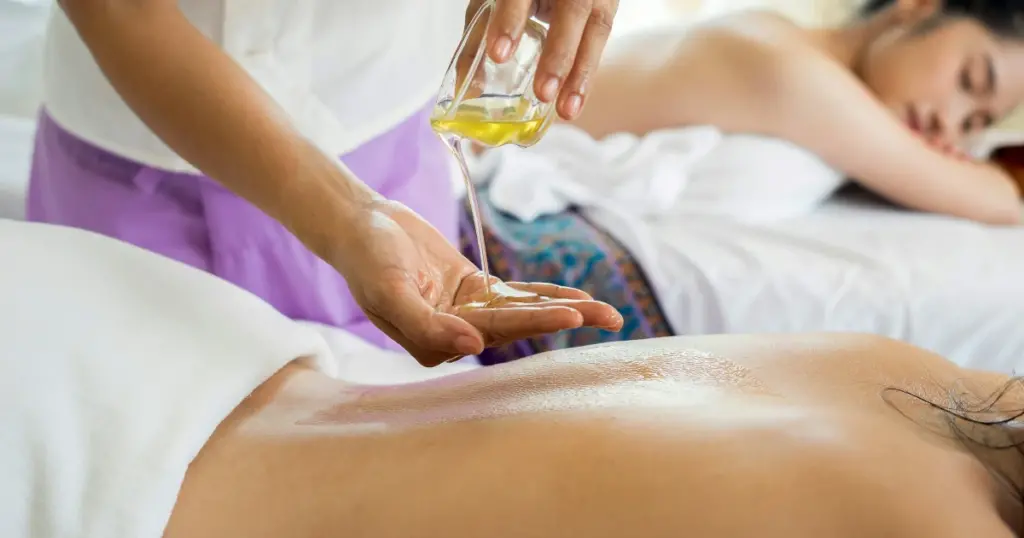1. Introduction
In a world where our daily lives are increasingly governed by technology, the allure of ancient healing practices has never been more pronounced. Thai massage, with its roots deeply embedded in the therapeutic traditions of Thailand, offers a respite from the stressors of modern living. It’s not merely a form of relaxation; it’s a comprehensive approach to wellness that has evolved over the years to combat the very ailments that plague our digital age, one of which is the ever-persistent lower back pain.
While the world has evolved with skyscrapers and sophisticated machinery, the human body, in many ways, remains a product of our evolutionary history. Designed for movement and agility, today’s sedentary lifestyle poses unique challenges, especially for our backs. The crux of the problem is that while we have made giant leaps in technology, our physical bodies often bear the brunt of this progress. Office workers hunched over computers, athletes pushing their limits, and construction workers performing repetitive tasks — all frequently report a familiar complaint: a throbbing, aching lower back.
Yet, how often do we genuinely seek to understand this pain? More often than not, we resort to quick fixes: over-the-counter painkillers, expensive ergonomic chairs, or even surgical procedures. While these may offer temporary relief, the solution might lie not in the new but in the old — specifically, the age-old techniques of Thai massage.
In the subsequent sections, we will traverse the lanes of history to understand the Thai massage’s genesis, dissect its techniques, and delve deep into its undeniable benefits for lower back pain. By the end of this exploration, we aim to answer a critical question: In the modern world, where quick fixes are the norm, can an ancient practice like Thai massage offer a lasting solution to lower back pain? For many, the answer might be a revelation, opening doors to a holistic approach to pain management that is both enlightening and therapeutic.

2. Background of Lower Back Pain
Today’s fast-paced, technologically-driven world presents a paradox: while we’ve made unprecedented advancements in comfort and convenience, our physical well-being often pays the price. Lower back pain, a nemesis for many, stands testament to this modern-day conundrum. To truly grasp the efficacy of Thai massage in addressing this ailment, we first need to understand the intricacies of lower back pain.
2.1. Causes of Lower Back Pain
Lower back pain is like the check engine light of the human body—a warning sign indicating that something isn’t quite right. Its causes are multifaceted and can range from fleeting to chronic:
-
Muscle Strain and Ligament Sprains: Often a result of heavy lifting or a sudden awkward movement, these strains can lead to muscle spasms, one of the most common sources of acute lower back pain.
-
Disc Herniation: The spine is composed of vertebrae cushioned by discs. When the soft material inside a disc herniates or bulges out, it can irritate the surrounding nerves, leading to pain.
-
Postural Problems: Office workers, beware! Extended periods of sitting, especially with poor posture, can exert excessive pressure on the discs and muscles of the lower back. The so-called “office syndrome” is, unfortunately, a growing concern in the corporate world.
-
Underlying Conditions: Conditions such as osteoporosis, spinal stenosis, and certain types of arthritis can also be culprits behind chronic back pain.
2.2. Prevalence in the Modern World
Lower back pain isn’t just a personal ailment; it’s a global epidemic. According to the World Health Organization, it is estimated that approximately 60-70% of individuals in industrialized countries experience lower back pain at some point in their life. The numbers are staggering and signal a pressing need for effective solutions.
-
Office Workers: Our target audience, especially those seated for extended periods, is particularly vulnerable. The sedentary nature of many modern jobs, combined with improper ergonomics and lack of regular movement, creates a recipe for persistent discomfort.
-
Athletes: While active, athletes aren’t immune. The rigorous training, repetitive movements, and occasional overexertion can strain the lower back. Recovery and pain management thus become integral to their regimen.
-
Construction Workers: Engaging in strenuous physical activities and often working in awkward postures, construction workers are another high-risk group. The repetitive lifting, bending, and twisting can take a toll on their backs.
In understanding the widespread prevalence and multifarious causes of lower back pain, we set the stage for a deeper exploration into Thai massage’s role in its management. As we journey further, we’ll uncover how this ancient practice, when tailored to modern needs, can offer respite to countless individuals seeking relief from this pervasive ailment.

3. Understanding Thai Massage
In our pursuit of well-being, it’s essential to recognize the profound power of holistic healing methods. One such method that has transcended the test of time is Thai massage. But what truly distinguishes Thai massage from the plethora of massage techniques available today? Let’s embark on a journey to understand this ancient practice’s depth, which might just be the antidote to modern-day physical ailments.
3.1. The Philosophy Behind Thai Massage
Thai massage isn’t just a set of hand movements or techniques; it’s a philosophy. Rooted in Thailand’s rich cultural tapestry, it draws inspiration from Buddhism, Indian Ayurvedic traditions, and ancient Chinese medicine.
-
Holistic Healing: At its core, Thai massage believes in the interconnectivity of the body, mind, and spirit. It’s not just about alleviating physical pain but restoring balance to the entire being. This perspective is particularly poignant in today’s fragmented world, where treatments often target symptoms rather than root causes.
-
Energy Flow: Thai massage places great emphasis on ‘Sen’ lines, akin to the meridians in Chinese medicine. By stimulating these energy pathways, the practice aims to remove blockages, enhancing the body’s natural energy flow, much like clearing clogs in a stream.
3.2. Modern vs. Traditional Techniques
While Thai massage has age-old roots, its evolution to cater to contemporary needs is noteworthy.
-
Traditional Techniques: Involving a series of stretches reminiscent of yoga, traditional Thai massage seeks to improve flexibility, reduce tension, and promote relaxation. Practitioners use not just their hands but also their feet, elbows, and knees to apply pressure, ensuring a comprehensive approach.
-
Modern Adaptations: Recognizing the unique challenges of the modern era, such as “office syndrome,” practitioners like those at Mai Thai Massage have integrated modern techniques. The fusion of traditional wisdom with contemporary understanding ensures a more tailored approach to diverse issues.
3.3. Specialized Thai Massage Techniques
Delving deeper, we find that Thai massage isn’t a monolithic entity; it branches into specialized techniques addressing specific needs.
-
Thai Barefoot Massage: A unique offering, this technique involves the practitioner using their feet to apply pressure. The larger surface area ensures broader coverage, making it particularly effective for deep tissue stimulation.
-
Thai Massage with Plai Oil from Wat Po: This is a testament to the practice’s adaptability. Plai oil, renowned for its pain-relieving properties, when combined with Thai massage techniques, offers enhanced relief, especially for chronic pain conditions.
-
Targeted Techniques for Office Syndrome: Recognizing the growing issue of pains arising from prolonged computer usage, specialized techniques focus on the neck, head, hands, and arms. It’s a tailored solution for the digital age.
In essence, Thai massage is a symphony of movements, pressures, and stretches, grounded in age-old wisdom but dynamically evolving to meet the demands of the modern world. As we’ve unveiled its philosophy and techniques, we’re better poised to appreciate its profound benefits, especially for prevalent concerns like lower back pain.
4. Five Proven Benefits of Thai Massage for Lower Back Pain
Lower back pain, as we’ve come to understand, is a multifaceted issue plaguing a large segment of our society. But amidst this backdrop of discomfort, Thai massage emerges as a beacon of hope. Here, we shall unveil five proven benefits of this ancient practice in mitigating lower back pain, substantiating why it might just be the holistic solution many seek.
4.1. Enhanced Blood Circulation
-
The Science: Good blood circulation is paramount for tissue health. When blood flow is optimized, nutrients and oxygen reach the muscles more efficiently, aiding in healing and reducing muscle fatigue.
-
Thai Massage’s Role: The rhythmic compressions inherent in Thai massage techniques act on the blood vessels, enhancing circulation. For those with lower back pain, this means faster recovery and alleviation from muscle soreness.
4.2. Improved Flexibility and Range of Motion
-
The Underlying Issue: Reduced flexibility can exacerbate lower back issues, limiting movement and making daily tasks a challenge.
-
The Magic of Thai Massage: Often dubbed “lazy man’s yoga,” Thai massage involves a series of stretches that help elongate muscles and release tension. This not only alleviates pain but also improves overall flexibility, granting individuals a broader range of motion.
4.3. Reduction in Muscle Tension and Spasms
-
Why it Matters: Muscle tension, especially in the lumbar region, can be a significant source of discomfort. Spasms can further aggravate this, leading to acute episodes of pain.
-
Thai Massage’s Answer: By working on the ‘Sen’ lines and applying strategic pressure, Thai massage aids in releasing this tension. For office workers and athletes alike, this means a respite from the tightness that often characterizes their lower back.
4.4. Alleviation of Stress and Anxiety
-
The Mind-Body Connection: It’s well-documented that mental stress can manifest physically, especially in the form of back pain.
-
Thai Massage’s Holistic Approach: Beyond its physical techniques, Thai massage embodies a philosophy of relaxation and mental well-being. By realigning energy flows and providing a calming ambiance, it offers mental tranquility, which indirectly can benefit the lower back.
4.5. Natural Pain Relief
-
Moving Beyond Medications: While painkillers might offer instant relief, they’re not devoid of side effects. A natural, side-effect-free solution is the need of the hour.
-
Thai Massage’s Therapeutic Touch: Techniques, especially when combined with the healing properties of Plai oil from Wat Po, can act as natural analgesics. They target pain’s root cause rather than just masking the symptoms, ensuring longer-lasting relief.
In conclusion, Thai massage, with its mosaic of techniques and philosophy, offers a comprehensive approach to lower back pain. It doesn’t merely address the physical manifestation of pain; it delves deeper, targeting the interconnected web of causes that contribute to this ailment. Whether you’re an office worker tethered to your desk or an athlete pushing boundaries, embracing Thai massage might be the key to unlocking a pain-free life.

5. Considering Thai Massage as a Solution
In the realm of therapeutic treatments for chronic ailments, the distinction between anecdotal praises and evidence-based practices is vital. While we’ve delved into the holistic virtues of Thai massage, the natural question arises: how does it stand when subjected to scientific scrutiny? Fortunately, comprehensive studies, such as the one published on ScienceDirect, offer valuable insights.
5.1. Thai Massage vs. Swedish Massage: A Comparative Study
In the quest to find the most effective solution for chronic low back pain, researchers have pitted traditional treatments against each other. The study titled “The effectiveness of Swedish massage and traditional Thai massage in treating chronic low back pain: A review of the literature” offers a comparative analysis.
-
Common Benefits: Both Swedish and traditional Thai massage have been found effective in enhancing physical functions, relieving pain, and ameliorating disability. Moreover, they also play a role in mitigating mental afflictions like anxiety and depression, underscoring the mind-body interconnectedness.
-
Edge of Thai Massage: What’s particularly compelling about the study is its conclusion regarding the superiority of Thai massage. Traditional Thai massage, when compared to Swedish massage, showcased a more pronounced impact in reducing pain intensity and improving disability.
5.2. Safety and Efficacy: Two Pillars of Treatment
The allure of any treatment isn’t just its effectiveness but also its safety. And this is where Thai massage shines brightly.
-
Safety First: The referenced study and several others in the domain attest to the safety of traditional Thai massage. When administered by trained practitioners, it poses minimal risks, making it a viable option for a broad demographic, from athletes to office workers.
-
Efficacy that Resonates: Beyond just immediate relief, the efficacy of Thai massage lies in its sustained impact. By targeting the root causes of pain and integrating both physical and mental healing, it offers a comprehensive solution that resonates long after the session concludes.
5.3. Tailored to Modern Needs
The world today, with its unique challenges like “office syndrome” and the rigors of demanding physical professions, necessitates treatments that are adaptable.
-
Specialized Techniques: As seen at establishments like Mai Thai Massage, the integration of both traditional and modern techniques ensures that Thai massage remains relevant. Whether it’s leveraging Plai Oil from Wat Po or techniques tailored to address digital age ailments, Thai massage evolves in tandem with contemporary needs.
-
Empowerment through Knowledge: An informed decision is an empowered one. Understanding the scientific backing of Thai massage, as highlighted by studies like the one on ScienceDirect, equips individuals with the knowledge to choose a treatment that aligns with their needs and preferences.
In summary, as we stand at the crossroads of tradition and modernity, Thai massage emerges as a beacon, its virtues validated by both ancient wisdom and modern science. For those grappling with the debilitating impacts of lower back pain, it beckons not just as a treatment but as a holistic journey towards well-being.

6. Conclusion
Navigating the intricate maze of chronic lower back pain solutions, we find ourselves at the intersection of ancient practices and modern needs. Thai massage, a tradition steeped in centuries of wisdom, has showcased its prowess not just in the annals of history but also under the rigorous lens of contemporary scientific research. As we stand on the cusp of an era where holistic well-being is paramount, understanding and embracing the potency of Thai massage becomes vital.
From the nuances of its techniques to the therapeutic aura it encapsulates, Thai massage offers a gamut of benefits. For our target audience, spanning diligent office workers to spirited athletes, this ancient art resonates with a promise of relief, rejuvenation, and revitalization. The diverse techniques, including specialized ones like Thai barefoot massage, not only cater to the physical ailments but also cradle the mind in a state of tranquility.
Reflecting upon the ScienceDirect article, one quote captures the essence of our exploration: “Traditional Thai massage was more effective than Swedish massage in reducing pain intensity and improving disability.” This statement not only underlines the efficacy of Thai massage but also elevates it on the global therapeutic stage.
While the treatments like Swedish massage have their own merits, the distinctiveness of Thai massage lies in its holistic approach. It’s not just about kneading muscles or aligning bones; it’s about harmonizing the body’s energy, about bridging the gap between the physical and the metaphysical. And when this is coupled with modern adaptations and insights, as seen at Mai Thai Massage, it becomes a solution that transcends time.
To our readers, both seasoned patrons of Thai massage and those standing on the threshold of discovery, remember: In the heart of Thai massage lies the promise of a life less burdened by pain, a life where well-being isn’t a luxury but a given. As we forge ahead, let us embrace this ancient wisdom, for in its folds might just lie the key to a brighter, pain-free tomorrow.

